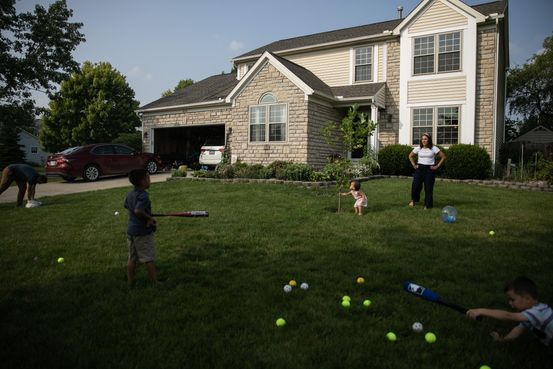What Fed Hikes? Much of Consumer Debt Is Still Riding Ultralow Rates
What Fed Hikes? Much of Consumer Debt Is Still Riding Ultralow Rates
In the depths of the pandemic, Alex and Cynthia Durbin refinanced their mortgage at 2.75%. They built up their savings by spending less, then paid off a car loan and student debt.
That meant the family’s balance sheet didn’t take a hit when the Federal Reserve started aggressively raising interest rates last year in an effort to cool inflation. The Fed on Wednesday raised rates to a 22-year high, the 11th increase since March 2022. Though most things cost more now, the Durbins still have room in their budget to dine out with their three young children and go on vacation a few times a year.
“It’s given us a tremendous amount of breathing room,” Durbin said of his mortgage rate.
Americans locked in ultralow rates on debt such as mortgages and auto loans in the decade-plus that followed the 2008 financial crisis. Though rates on some loans such as credit cards are rising with the Fed’s hikes, a huge chunk of consumer debt carries the low yields on offer a few years ago. That has allowed many households to continue spending, which has kept the economy going strong despite predictions of a recession.
As of the first quarter, only 11% of outstanding household debt carried rates that fluctuated with benchmark interest rates, according to Moody’s Analytics. That metric has hovered around this historically low level for over a decade. But it only started to matter when the Fed began its campaign.
Fixed-rate debt became more common after the 2008 crisis, when lenders turned away from products such as adjustable-rate mortgages and home-equity lines of credit that played a role in the bust. Households have also spent the past decade-plus loading up on auto and student loans, which typically carry fixed rates.
Households would have to pay 9.6% of their disposable income to stay current on their debts in the first quarter, according to the Fed. That is above where it was in the depths of the pandemic but below the postcrisis average.
The prevalence of fixed-rate debt is likely blunting the impact of the central bank’s moves. Economic growth and consumer spending remain mostly solid. One popular gauge suggests that the Fed’s moves are having less of an effect on financial conditions than earlier this year.
“It’s one reason why consumers are hanging tough and the Fed’s rate hikes have taken less of a bite out of the economy,” said Mark Zandi, chief economist at Moody’s Analytics.
Americans who refinanced their mortgages for a better rate since March 2020 have saved $42 billion on their monthly payments, Black Knight estimates.
Some who nabbed low rates do feel stuck in place: Upgrading to the next home or car is now prohibitively expensive. The national housing market is paralyzed by homeowners who aren’t moving because they don’t want to give up their cheap mortgages.
Alex Durbin, who is 36 and works in private-wealth management, said his family of five is outgrowing their three-bedroom home in the Columbus, Ohio, area. They bought a plot of land for a new home but, with mortgage rates around 7%, they can’t afford to build the house they want. “We’re in this weird limbo state,” he said.
Durbin said they could also use a car with more space, but they plan to stick with their paid-off Honda Odyssey minivan with 135,000 miles for now. “I don’t even want to think about what it would cost to finance,” he said.
Still, the cheap, fixed-rate debt has generally put borrowers in a better financial position. Many bought properties that have already risen in value. Some are also taking advantage of higher rates on savings accounts and Treasurys—making them overall winners in the central bank’s campaign.
Michael and Niki Reznicek weren’t planning on buying a home in 2021. But after the pandemic prompted the Fed to cut rates to near zero and mortgage rates fell, they put their savings toward a down payment on a Chicago townhome. Their mortgage rate was around 3.25%. In today’s market, they wouldn’t be able to buy the same home.
Their spending has mostly stayed the same. “I still go get my Starbucks, we still go out and tip 20 to 25 percent at restaurants,” said Michael Reznicek, who is 28 and works in financial technology. The couple does look for sale items at the grocery store more frequently, he said.
Gary Marsh, 66, paid cash to build his Sonoma County, Calif., home in 2020 and the following year took out a 2.75% mortgage on the property that provided him with a lump sum of about $300,000. He recently put those funds into certificates of deposit at local banks paying about 4.75%.
“The low mortgage rate has allowed me to work less, travel more and mostly to feel more free than I ever have,” said Marsh, a writer for real-estate companies.
Source: WSJ











